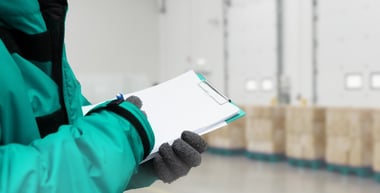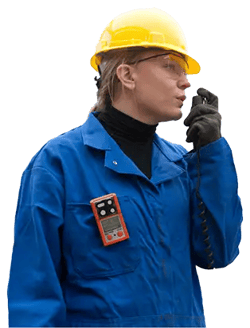Personal gas monitors are lifesaving instruments that must be worn in your breathing zone to be effective. OSHA defines the breathing zone as “a hemisphere forward of the shoulders within a radius of approximately six to nine inches,” so a collar, lapel, or outside breast pocket is usually a good option. This location also keeps the monitor visible so you can see alerts if your hearing is impaired while working in a high-noise environment.
Unfortunately, wearing a gas detector within six to nine inches of your nose and mouth means that whatever dirt, grime, or bacteria your monitor has picked up is now in your breathing zone.
If you need to clean your personal gas monitor, your first instinct might be to grab a disinfecting wipe, like you would for any other surface. This is a bad idea.
Why You Shouldn’t Use Regular Disinfectants
The precision sensors in your monitor are highly sensitive to many different chemicals, including alcohol and other disinfectants, so using them could prevent your monitor from alerting you to gas hazards. Additionally, alcohol-based cleaners will cause your monitor to go into alarm. If you zero the monitor too soon, the monitor will read falsely low, potentially putting you in unsafe conditions.
The rubber, plastics, and barriers in your monitor can also absorb the disinfectant chemicals. This is problematic because these are some of the same chemicals you may monitor. This effect does not last long, but the length of time you need to wait before zeroing varies, so the approach leaves plenty of room for error.
How to Clean a Gas Detector— Without Damaging It
For typical dirt and grime, we recommend wiping down your gas detector with a soap and water solution of 8 to 10 parts water to one part dish soap, like Dawn®. This cleans the monitor with less risk of damaging the sensors or putting you at risk of a malfunction. However, the soap and water approach cleans the monitor of everyday buildup—it does not necessarily kill bacteria or viruses that may exist on the surface.
To give your monitor a more serious cleaning, wipe down your monitor with a bleach and water solution of approximately 50 parts water to one part bleach recommended by the Centers for Disease Control (CDC). The CDC advises using 5 tablespoons of bleach per gallon of water or 4 teaspoons of bleach per quart of water (approximately 20 milliliters per liter).
You can use this same method to sanitize a docking station, allowing it to dry completely before use.
For more information on general practices for disinfection, please refer to the CDC’s Environmental Cleaning and Disinfection Recommendations.
No matter which cleaning method you use, be sure to dock the monitor or bump test it to be sure it's working properly.
Download a printable PDF of this blog post.




